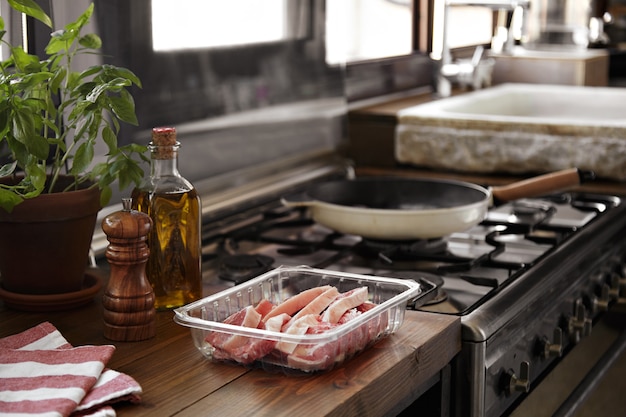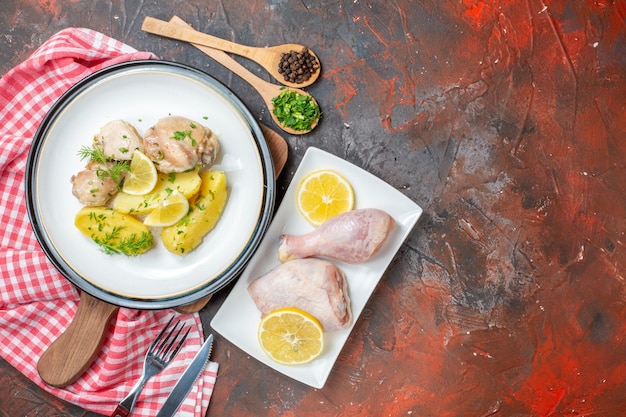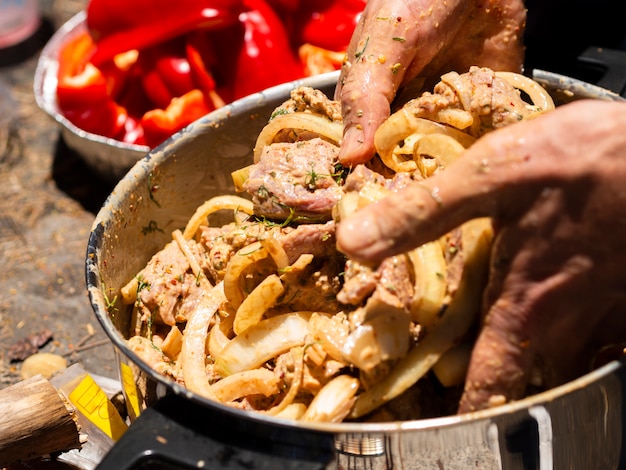Let's be honest, sometimes you just crave a simple, satisfying meal that doesn't require hours of prep work, right? And what could be easier and more delicious than perfectly cooked chicken tenderloins? I'm talking about juicy, succulent chicken, cooked to a golden-brown perfection right on the stovetop. I've been there myself, staring into the abyss of an empty fridge, wondering what to make for dinner. But over time, I've learned a few tricks and tips, and I’m excited to share them with you so you can create restaurant-quality chicken tenderloins in your own kitchen.
Now, I know what you might be thinking – “chicken tenderloins? That sounds a little boring.” But trust me, with the right techniques and a few flavorful additions, these little nuggets of deliciousness can become your go-to weeknight dinner. They're incredibly versatile, lending themselves to a wide range of sauces and sides. Think zesty lemon-herb chicken with roasted vegetables, sweet and spicy glazed tenders with rice, or even a classic chicken parmesan. The possibilities are practically endless!
Part 1: Choosing the Right Chicken Tenderloins

The first step to achieving those perfect chicken tenderloins is choosing the right ones. I've been there, standing in the supermarket aisle, staring at the various packs of chicken tenderloins, wondering which ones are the best. My advice? Opt for fresh chicken tenderloins whenever you can. They tend to be juicier and tastier than frozen ones. But if frozen is all you have on hand, make sure to thaw them properly in the refrigerator overnight before cooking.
A Quick Tip on Thawed Chicken
Speaking of thawing, I've got a little tip that's made a big difference for me. When thawing frozen chicken tenderloins, pat them dry with paper towels before cooking. This helps to remove any excess moisture and ensures that they cook evenly and develop that lovely golden-brown crust we all crave.
Part 2: Preparing the Chicken Tenderloins

Now that you've got your chicken tenderloins ready to go, let's get them prepped for cooking! This is where you can get creative with your seasonings and marinades. I'm a big fan of using a simple mixture of salt, pepper, and paprika, but feel free to experiment with any spices that you enjoy. A dash of garlic powder or onion powder never hurts either. You can also marinate the chicken in a mixture of olive oil, lemon juice, and herbs for a few hours to add extra flavor and make them even more tender.
Some More Ideas for Marinating
Here are a few more ideas for marinades that have worked wonders for me:
- Soy sauce, honey, and ginger: This marinade creates a sweet and savory glaze that's both delicious and easy to make.
- Yogurt, turmeric, and cumin: This marinade adds a creamy, vibrant flavor to the chicken. The turmeric adds a warm, earthy note, and the cumin provides a touch of spice.
- Mustard, honey, and garlic: This marinade gives the chicken a tangy and flavorful kick. The honey adds a touch of sweetness, and the garlic adds a pungent aroma.
Part 3: The Stovetop Cooking Method

Now, the moment of truth. It's time to cook those chicken tenderloins to perfection. My preferred method? Stovetop cooking. I've tried everything from baking to grilling, but nothing beats the simplicity and control of the stovetop. You have more direct control over the cooking process, which is crucial for achieving that crispy exterior and juicy interior.
The cast iron pan: A Kitchen Hero
I'm a big fan of using a cast iron pan for this task. They distribute heat evenly, giving you that beautiful, crispy crust you crave. Plus, they're super durable and can withstand high temperatures. They get seasoned over time, adding a unique depth of flavor to your cooking. But if you don't have a cast iron pan, don't worry! Any heavy-bottomed frying pan will do the trick. Just make sure it's large enough to fit all your chicken tenderloins in a single layer, without overcrowding them.
Part 4: Heating Your Pan
With your pan ready, it's time to heat it up. Turn the heat to medium-high and add a little bit of oil to the pan. I like to use olive oil because it has a high smoke point, meaning it won't burn easily at high temperatures. However, you can use any oil you prefer, such as avocado oil or grapeseed oil. Once the oil is shimmering, it's ready to go.
Part 5: Adding the Chicken Tenderloins
Carefully place your chicken tenderloins in the hot pan. Make sure there's enough space between them so they cook evenly on all sides. I've learned the hard way that overcrowding the pan will lead to uneven cooking and potentially soggy chicken. So, don't be afraid to cook in batches if needed. It's better to have a few rounds of cooking than to rush the process and end up with less than perfect results.
Don't Touch the Chicken
Once the chicken is in the pan, resist the urge to poke, prod, or move it around. Let it cook undisturbed for about 3-4 minutes on each side. This will allow the chicken to brown nicely and develop a crispy crust. You'll know it's ready to flip when it's easily released from the pan and has a beautiful golden-brown color. If it's sticking, give it another minute or so to cook before trying to flip it.
Part 6: Checking for Doneness
After about 10-12 minutes of cooking, it's time to check if the chicken is cooked through. I always use a meat thermometer to ensure that the internal temperature reaches 165°F (74°C). This is the safe temperature for chicken, and it guarantees that it's cooked all the way through. If you don't have a meat thermometer, you can check by cutting into the thickest part of the chicken. The juices should run clear, and there should be no pink color in the meat. If it's still pink, return it to the pan and cook for a few more minutes, checking again periodically.
Part 7: Serving and Enjoying!
Congratulations! You've just cooked perfect chicken tenderloins on the stovetop. Now it's time to enjoy your culinary masterpiece. I love serving mine with a side of mashed potatoes, roasted vegetables, or a simple salad. Don't forget to add a drizzle of sauce for extra flavor. Some of my favorites include lemon-herb sauce, teriyaki sauce, or a creamy mushroom sauce. But feel free to get creative and experiment with different flavors!
Part 8: Tips for Storing and Reheating
Have leftover chicken tenderloins? No problem! They can be stored in the refrigerator for up to 3-4 days. To reheat, you can simply microwave them, or you can pan-fry them in a little bit of oil for a few minutes until heated through. I prefer the pan-frying method, as it helps to crisp up the chicken again and gives it a more flavorful finish.
Part 9: Variations and Alternatives
Want to switch things up a bit? You can easily add more flavor and variety to your chicken tenderloins by trying these variations:
Spicy Chicken Tenderloins: For the Heat Seekers
For a fiery kick, add some cayenne pepper or chili flakes to your marinade. You can also use a spicy sauce, like sriracha or habanero sauce, for a real punch. Experiment with different spice levels to find what suits your taste.
Honey-Glazed Chicken Tenderloins: Sweet and Savory Delight
For a sweet and sticky treat, try glazing your chicken tenderloins with a honey-soy sauce mixture. You can also add a touch of sesame oil and ginger for a more complex flavor. This glaze is fantastic when paired with rice or noodles.
Lemon-Herb Chicken Tenderloins: A Classic for a Reason
This classic combination is always a crowd-pleaser. Simply marinade your chicken tenderloins in a mixture of olive oil, lemon juice, and fresh herbs, such as rosemary, thyme, or parsley. The lemon adds a bright and tangy flavor, while the herbs provide a delicate aroma.
Part 10: FAQs
1. What if my chicken tenderloins are too thick?
If your chicken tenderloins are too thick, you can cut them in half lengthwise to ensure even cooking. Just make sure to adjust your cooking time accordingly, adding a minute or two to each side.
2. Can I cook frozen chicken tenderloins?
While it's best to cook fresh chicken tenderloins, you can cook frozen ones if necessary. However, you'll need to increase the cooking time by a few minutes to ensure that they cook through completely. Be sure to thaw them properly in the refrigerator before cooking, and pat them dry with paper towels. You may need to add a few more minutes to your cooking time to ensure the chicken is cooked through.
3. What if my chicken tenderloins are sticking to the pan?
If your chicken tenderloins are sticking to the pan, it's likely because the pan isn't hot enough. Increase the heat to medium-high and let the pan heat up for a few more minutes before adding the chicken. You can also try adding a little more oil to the pan.
4. What can I serve with chicken tenderloins?
Chicken tenderloins are incredibly versatile and can be paired with a variety of sides. Some popular choices include mashed potatoes, roasted vegetables, rice, pasta, and salads.
5. What are some tips for making sure my chicken tenderloins are juicy?
To ensure that your chicken tenderloins are juicy, make sure to cook them over medium-high heat and don't overcook them. You can also try marinating the chicken in a flavorful mixture of oil, lemon juice, and herbs for extra moisture. Overcooking is the enemy of juicy chicken, so keep a close eye on the temperature.
Part 11: Conclusion
There you have it! My foolproof guide to cooking perfect chicken tenderloins on the stovetop. Now, you might be thinking, "Why did I bother with takeout all this time?" I've been there, trust me. It's all about finding that perfect balance of flavors and textures. So next time you're craving a quick and easy meal, ditch the takeout and give this recipe a try. You won't be disappointed.
Remember, practice makes perfect. The more you cook chicken tenderloins, the more comfortable you'll become with the process. Experiment with different seasonings and sauces to find your favorites. Enjoy the process of creating delicious and satisfying meals at home. You've got this!
Everyone is watching

Corn on the Cob: The Ultimate Guide to Perfectly Cooked Ears
Healthy MealsAh, corn on the cob. Just the name evokes images of sunny days, barbecues, and that sweet, juicy flavour that ...

Scallops: The Ultimate Guide to Perfect Cooking
Healthy MealsAh, scallops. Those delicate, sweet, and utterly delicious morsels of the sea. They hold a special place in my...

Spaghetti Squash: The Ultimate Guide to Cooking and Serving
Healthy MealsRemember that time you saw spaghetti squash at the supermarket, looking all bumpy and strange, and thought, "W...

Salmon Cooking Times: Perfect Guide for Every Recipe
Healthy MealsLet me tell you, cooking salmon is an art form. It's all about getting that perfect balance: juicy and tender,...

Ham Cooking Time: How Long to Bake, Smoke, or Boil a Delicious Ham
Healthy MealsAh, ham. It's a classic, isn't it? A real crowd-pleaser, especially around holidays. And when done right, it'...
